
The British Museum is a public museum dedicated to human history, art and culture located in the Bloomsbury area of London. Its permanent collection of eight million works is the largest in the world. It documents the story of human culture from its beginnings to the present. The British Museum was the first public national museum to cover all fields of knowledge.

In Greek mythology, Hypnos, also spelled Hypnus, is the personification of sleep; the Roman equivalent is known as Somnus. His name is the origin of the word hypnosis. Pausanias wrote that Hypnos was the dearest friend of the Muses.

Hephaestus is the Greek god of artisans, blacksmiths, carpenters, craftsmen, fire, metallurgy, metalworking, sculpture and volcanoes. Hephaestus's Roman counterpart is Vulcan. In Greek mythology, Hephaestus was either the son of Zeus and Hera or he was Hera's parthenogenous child. He was cast off Mount Olympus by his mother Hera because of his lameness, the result of a congenital impairment; or in another account, by Zeus for protecting Hera from his advances.

Reggio di Calabria, commonly and officially referred to as Reggio Calabria, or simply Reggio by its inhabitants, is the largest city in Calabria as well as the seat of the Regional Council of Calabria. It has an estimated population between 150,000 and 200,000 and is the twenty-first most populous city in Italy, after Modena and other Italian cities, and the 100th most populated city in Europe. Reggio Calabria is located near the center of the Mediterranean and is known for its climate, ethnic and cultural diversity. It is the third economic centre of mainland Southern Italy. About 560,000 people live in the metropolitan area, recognised in 2015 by Italy as a metropolitan city.
Locri is a town and comune (municipality) in the province of Reggio Calabria, Calabria, southern Italy. Its name derives from that of the ancient Greek region of Locris. Today it is an important administrative and cultural centre on the Ionian Coast and within its province.

In Greek mythology, Ixion was king of the Lapiths, the most ancient tribe of Thessaly.

Hebe, in ancient Greek religion and mythology, often given the epithet Ganymeda, is the goddess of youth or of the prime of life. She functioned as the cupbearer for the gods and goddesses of Mount Olympus, serving their nectar and ambrosia. People of Sicyon also worshipped her as the goddess of forgiveness or of mercy.

Cattle are prominent in some religions and mythologies. As such, numerous peoples throughout the world have at one point in time honored bulls as sacred. In the Sumerian religion, Marduk is the "bull of Utu". In Hinduism, Shiva's steed is Nandi, the Bull. The sacred bull survives in the constellation Taurus. The bull, whether lunar as in Mesopotamia or solar as in India, is the subject of various other cultural and religious incarnations as well as modern mentions in New Age cultures.

Paestum was a major ancient Greek city on the coast of the Tyrrhenian Sea, in Magna Graecia. The ruins of Paestum are famous for their three ancient Greek temples in the Doric order dating from about 550 to 450 BC that are in an excellent state of preservation. The city walls and amphitheatre are largely intact, and the bottom of the walls of many other structures remain, as well as paved roads. The site is open to the public, and there is a modern national museum within it, which also contains the finds from the associated Greek site of Foce del Sele.
San Sosti is a comune in the province of Cosenza, in Calabria, southern Italy.

Lamezia Terme, commonly called Lamezia, is an Italian city and comune of 70,452 inhabitants (2013), in the province of Catanzaro in the Calabria region.

Scylletium or Skylletion or Scolacium was an ancient seaside city in Calabria, southern Italy. Its ruins can be found at the frazione of Roccelletta, near Catanzaro, facing the Gulf of Squillace.

Capo Colonna is a cape in Calabria located near Crotone. In ancient Roman times the promontory was called Promunturium Lacinium. The modern name derives from the remaining column of the Temple of Hera Lacinia.

Terina was an ancient city located on the Piano di Tirena hill in Sant'Eufemia Vetere about 20 km (12 mi) from Lamezia Terme in Calabria. The site of the city was allegedly found in 1922 by the archaeologist Paolo Orsi near the modern village of Sant'Eufemia Vetere. A systematic archaeological investigation was made from 1997 and coins, inscriptions and other artefacts retrieved from the site can be seen in the Museo Archeologico Lametino in Lamezia Terme.

Art in bronze and brass dates from remote antiquity. These important metals are alloys, bronze composed of copper and tin and brass of copper and zinc.

The Aegina Treasure or Aigina Treasure is an important Minoan gold hoard said to have been found on the island of Aegina, Greece. Since 1892, it has been part of the British Museum's collection. It is one of the most important groups of Minoan jewellery.

The Bronze Head of Hypnos is a Roman copy of an ancient Greek statue found at Civitella d'Arna near Perugia in central Italy. Widely copied since its discovery in the early nineteenth century, it has been part of the British Museum's collection since 1868.

The Kang Hou gui is a bronze vessel that is said to have been taken from the city of Huixian, Henan province, central China. Dating to the Western Zhou period, this ancient Chinese artefact is famous for its inscription on the bottom of the interior. It has been part of the British Museum's Asian Collections since 1977.

The Temple of Juno Lacinia is a ruined ancient Greek temple at the heart of a sanctuary dedicated to Hera located on Capo Colonna in Calabria, Italy, near Crotone. The main remaining feature is a Doric column with capital, about 27 feet (8.2 m) in height.
Stymphalus or Stymphalos was a town in the northeast of ancient Arcadia.
















